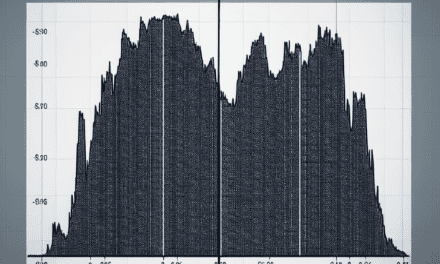“Markets Surge Amid Post-Election Optimism, Awaiting Fed’s Next Move”
Introduction
Following the recent elections, financial markets have experienced a notable rally, reflecting investor optimism and recalibrated expectations. This surge comes amid anticipation of the Federal Reserve’s upcoming decision on interest rates, which is poised to influence economic policy and market dynamics significantly. The post-election landscape has introduced a wave of confidence among investors, driven by potential policy shifts and economic strategies that could emerge from the newly elected government. As the Federal Reserve prepares to announce its decision, market participants are closely monitoring economic indicators and policy signals, understanding that the central bank’s actions will play a crucial role in shaping the economic outlook and sustaining the current market momentum.
Impact Of Election Results On Market Sentiment
In the wake of the recent election results, financial markets have experienced a notable rally, reflecting a shift in investor sentiment. This surge in market activity can be attributed to the perceived stability and policy clarity that often follow electoral outcomes. Investors, who had been navigating a period of uncertainty leading up to the elections, are now recalibrating their strategies based on the anticipated economic policies of the newly elected officials. The election results have provided a clearer picture of the political landscape, which in turn has influenced market sentiment positively.
The immediate impact of the election on the markets is evident in the performance of major indices, which have shown significant gains. This rally is largely driven by investor optimism regarding potential policy changes that could stimulate economic growth. For instance, sectors such as infrastructure, healthcare, and technology have seen increased investor interest, as these areas are expected to benefit from the new administration’s policy priorities. Moreover, the prospect of increased government spending and regulatory adjustments has further fueled this optimism, as investors anticipate a more favorable business environment.
However, while the election results have provided a temporary boost to market sentiment, the looming decision by the Federal Reserve adds a layer of complexity to the current economic landscape. The Fed’s upcoming meeting is highly anticipated, as it will provide crucial insights into the central bank’s monetary policy direction. Investors are particularly keen to understand the Fed’s stance on interest rates, as any adjustments could have significant implications for market dynamics. The interplay between fiscal policy, shaped by the election outcomes, and monetary policy, guided by the Fed, will be critical in determining the trajectory of the markets in the coming months.
As the Fed deliberates on its next move, market participants are closely monitoring economic indicators such as inflation rates, employment figures, and GDP growth. These metrics will play a pivotal role in shaping the Fed’s decision-making process. A key concern for investors is the potential for interest rate hikes, which could dampen the current market rally by increasing borrowing costs and reducing consumer spending. Conversely, a more accommodative monetary policy stance could sustain the positive momentum by keeping financial conditions favorable for growth.
In addition to domestic factors, global economic conditions also influence market sentiment. The interconnectedness of global markets means that developments in major economies, such as China and the European Union, can have ripple effects on investor confidence. Trade relations, geopolitical tensions, and international economic policies are all variables that investors must consider as they navigate the post-election market environment.
In conclusion, the recent election results have undeniably impacted market sentiment, providing a boost to investor confidence and driving a rally in financial markets. However, the forthcoming Federal Reserve decision remains a critical factor that could either reinforce or temper this optimism. As investors await further clarity on monetary policy, they must remain vigilant and adaptable, considering both domestic and global economic developments. The interplay between fiscal and monetary policies will ultimately shape the market landscape, influencing investment strategies and economic outcomes in the near future.
Federal Reserve’s Role In Post-Election Market Dynamics
In the wake of the recent elections, financial markets have experienced a notable rally, reflecting investor optimism and a renewed sense of stability. This surge in market activity can be attributed to several factors, including the resolution of political uncertainties and the anticipation of forthcoming economic policies. However, as the dust settles from the electoral process, attention is now shifting towards the Federal Reserve and its impending decisions, which are poised to play a crucial role in shaping the post-election market dynamics.
The Federal Reserve, as the central bank of the United States, wields significant influence over the economy through its monetary policy tools. In the current context, the Fed’s decisions regarding interest rates and asset purchases are of paramount importance to investors and market participants. The anticipation of these decisions has already begun to influence market behavior, as investors attempt to gauge the Fed’s next moves in response to evolving economic conditions.
One of the primary concerns for the Federal Reserve is the state of inflation, which has been a persistent issue in recent months. Rising prices have put pressure on the Fed to consider tightening its monetary policy, potentially through interest rate hikes or a reduction in its asset purchase program. Such measures are intended to curb inflationary pressures but also carry the risk of slowing economic growth. Consequently, the Fed faces a delicate balancing act as it seeks to maintain price stability while supporting the ongoing economic recovery.
Moreover, the outcome of the elections has implications for fiscal policy, which in turn affects the Fed’s approach. With a clearer picture of the political landscape, there is potential for new fiscal measures that could either complement or complicate the Fed’s efforts. For instance, increased government spending on infrastructure or social programs could stimulate economic growth, potentially reducing the need for aggressive monetary intervention. Conversely, if fiscal policy remains constrained, the Fed may feel compelled to take more decisive action to support the economy.
As investors navigate this complex environment, they are closely monitoring the Fed’s communications for any indications of its future policy direction. The central bank’s statements and projections are scrutinized for clues about its assessment of economic conditions and its likely course of action. This heightened focus on the Fed underscores its pivotal role in shaping market expectations and influencing investment decisions.
In addition to domestic factors, global economic conditions also play a role in the Fed’s decision-making process. The interconnectedness of the global economy means that developments abroad can have significant implications for U.S. markets. For example, economic slowdowns in major trading partners or geopolitical tensions can impact trade flows and financial stability, thereby influencing the Fed’s policy considerations.
In conclusion, as markets rally in the aftermath of the elections, the Federal Reserve’s role in post-election market dynamics cannot be overstated. Its decisions on monetary policy will be critical in determining the trajectory of the economy and the sustainability of the current market rally. Investors and market participants will continue to pay close attention to the Fed’s actions and communications, as they seek to navigate the complexities of a rapidly evolving economic landscape. The interplay between political developments, fiscal policy, and the Fed’s monetary strategy will undoubtedly shape the financial markets in the months to come, making the central bank’s role more crucial than ever.
Historical Analysis Of Market Rallies Following Elections
In the aftermath of elections, financial markets often experience a period of heightened activity, characterized by rallies that reflect investor sentiment and expectations for future economic policies. Historically, these post-election rallies have been influenced by a myriad of factors, including the political landscape, anticipated fiscal policies, and broader economic conditions. As we delve into the historical analysis of market rallies following elections, it becomes evident that these movements are not merely reactions to electoral outcomes but are also shaped by the anticipation of subsequent monetary policy decisions, particularly those made by the Federal Reserve.
To understand the dynamics of post-election market rallies, it is essential to consider the historical context. For instance, the stock market has often responded positively to the resolution of electoral uncertainty. Investors, who typically dislike uncertainty, tend to react favorably once election results are finalized, regardless of the winning party. This phenomenon was notably observed in the aftermath of the 2016 U.S. presidential election, where markets rallied significantly, driven by expectations of pro-business policies and tax reforms. Similarly, the 2020 election saw a robust market response, as investors anticipated substantial fiscal stimulus and accommodative monetary policies to support economic recovery amid the pandemic.
Moreover, the role of the Federal Reserve in shaping post-election market rallies cannot be understated. The Fed’s monetary policy decisions, particularly regarding interest rates and quantitative easing, have a profound impact on market sentiment. Historically, when the Fed has signaled a dovish stance, indicating a willingness to keep interest rates low to support economic growth, markets have responded with optimism. This was evident in the post-election period of 2008, during the global financial crisis, when the Fed’s aggressive monetary easing measures helped stabilize financial markets and foster a rally.
Transitioning to more recent times, the interplay between election outcomes and Fed decisions continues to be a focal point for investors. As the Federal Reserve’s policy meetings loom on the horizon, market participants keenly analyze the potential implications of electoral results on future monetary policy. The anticipation of Fed actions, such as interest rate adjustments or changes in asset purchase programs, often amplifies market movements in the post-election period. Investors speculate on how the newly elected administration’s policies might influence the Fed’s economic outlook and policy trajectory.
Furthermore, it is important to recognize that while historical patterns provide valuable insights, each election cycle presents unique circumstances that can influence market behavior. Factors such as geopolitical tensions, global economic conditions, and technological advancements can all play a role in shaping the market’s response to elections. Therefore, while historical analysis offers a framework for understanding potential market reactions, it is crucial for investors to remain vigilant and adaptable to evolving conditions.
In conclusion, the historical analysis of market rallies following elections reveals a complex interplay between electoral outcomes, investor sentiment, and Federal Reserve decisions. While markets often rally post-election due to the resolution of uncertainty and expectations of favorable policies, the Fed’s monetary policy stance plays a critical role in sustaining or tempering these rallies. As investors navigate the post-election landscape, they must consider both historical precedents and current economic indicators to make informed decisions. Ultimately, the ability to anticipate and respond to these multifaceted influences is key to understanding and capitalizing on post-election market dynamics.
Investor Strategies Amidst Political And Economic Uncertainty
In the wake of the recent elections, financial markets have experienced a notable rally, providing a sense of optimism among investors. This surge in market activity can be attributed to a combination of political clarity and anticipation of upcoming economic decisions, particularly those related to the Federal Reserve’s monetary policy. As investors navigate this landscape, understanding the interplay between political developments and economic indicators becomes crucial for formulating effective investment strategies.
The conclusion of the election cycle has brought a degree of certainty to the political environment, which often translates into increased investor confidence. Historically, markets tend to react positively when election outcomes are clear, as this reduces the ambiguity surrounding future policy directions. With the political landscape now more defined, investors are better positioned to assess potential policy impacts on various sectors, allowing for more informed decision-making.
However, while the political dust may have settled, the economic horizon remains clouded with uncertainty, primarily due to the impending decisions by the Federal Reserve. The central bank’s approach to interest rates and monetary policy will significantly influence market dynamics in the coming months. Investors are keenly watching for signals from the Fed regarding its stance on inflation and economic growth, as these factors will dictate the cost of borrowing and, consequently, corporate profitability and consumer spending.
In this context, investors are advised to adopt a balanced approach, considering both the opportunities and risks presented by the current environment. Diversification remains a key strategy, as it allows investors to spread risk across different asset classes and sectors. By doing so, they can mitigate potential losses in one area with gains in another, thereby achieving a more stable overall portfolio performance.
Moreover, investors should pay close attention to sectors that are likely to benefit from the new political landscape. For instance, industries that align with the prevailing administration’s policy priorities, such as renewable energy or infrastructure, may experience growth due to increased government support and investment. Conversely, sectors facing potential regulatory challenges may warrant a more cautious approach.
In addition to sectoral considerations, global economic trends also play a pivotal role in shaping investor strategies. The interconnectedness of global markets means that developments in one region can have ripple effects worldwide. As such, keeping an eye on international trade dynamics, geopolitical tensions, and foreign monetary policies is essential for a comprehensive investment strategy.
Furthermore, the current economic climate underscores the importance of staying informed and adaptable. Investors should remain vigilant, continuously monitoring economic indicators such as employment rates, consumer confidence, and corporate earnings reports. By staying abreast of these developments, they can make timely adjustments to their portfolios, capitalizing on emerging opportunities while minimizing exposure to potential downturns.
In conclusion, as markets rally post-election and the Federal Reserve’s decision looms, investors find themselves at a crossroads of political and economic uncertainty. By embracing a diversified approach, focusing on sectors poised for growth, and remaining attuned to global trends, investors can navigate this complex landscape with greater confidence. Ultimately, the ability to adapt to changing conditions and make informed decisions will be key to achieving long-term investment success in this evolving environment.
Sector Performance In A Post-Election Rally Environment
In the wake of the recent elections, financial markets have experienced a notable rally, with investors responding positively to the political outcomes. This post-election environment has created a dynamic landscape for various sectors, each reacting differently to the shifting political and economic expectations. As the Federal Reserve’s upcoming decision on interest rates looms, market participants are closely monitoring sector performance to gauge potential impacts on their portfolios.
The technology sector, often seen as a bellwether for market sentiment, has been a significant beneficiary of the post-election rally. Investors are optimistic about the potential for continued innovation and growth, particularly in areas such as artificial intelligence and cloud computing. This optimism is further fueled by expectations of favorable regulatory conditions, which could provide a conducive environment for tech companies to expand their operations and increase profitability. Consequently, tech stocks have seen a surge in demand, driving up their valuations and contributing to the overall market rally.
Meanwhile, the healthcare sector has also experienced a boost, albeit for different reasons. The election results have alleviated some of the uncertainties surrounding healthcare policy, leading to increased investor confidence. With a clearer understanding of the regulatory landscape, healthcare companies are better positioned to plan for the future, which has translated into improved stock performance. Additionally, the ongoing focus on healthcare innovation, particularly in pharmaceuticals and biotechnology, has attracted significant investment, further bolstering the sector’s performance.
In contrast, the energy sector has faced a more complex set of challenges in the post-election environment. While the rally has provided some support, the sector remains under pressure due to fluctuating oil prices and the global push towards renewable energy sources. Investors are cautiously optimistic, hoping for policy measures that could support traditional energy industries while also facilitating a transition to cleaner alternatives. As such, energy stocks have experienced mixed performance, with some companies benefiting from short-term gains while others continue to navigate long-term uncertainties.
The financial sector, on the other hand, stands at a critical juncture as the Federal Reserve’s decision on interest rates approaches. Banks and financial institutions are particularly sensitive to changes in interest rates, which can significantly impact their profitability. A potential rate hike could lead to increased borrowing costs, affecting consumer spending and business investment. However, it could also result in higher net interest margins for banks, potentially boosting their earnings. As a result, financial stocks have shown resilience in the post-election rally, with investors weighing the potential benefits and risks associated with the Fed’s upcoming decision.
As markets continue to navigate the post-election landscape, the interplay between political developments and economic policy remains a key driver of sector performance. Investors are keenly aware of the potential implications of the Federal Reserve’s decision, which could either sustain the current rally or introduce new volatility. In this environment, diversification across sectors may prove to be a prudent strategy, allowing investors to capitalize on opportunities while mitigating risks. Ultimately, the post-election rally serves as a reminder of the complex and interconnected nature of financial markets, where political outcomes and economic policies converge to shape the investment landscape.
Global Market Reactions To U.S. Election Outcomes
In the wake of the recent U.S. elections, global markets have experienced a notable rally, reflecting investor optimism and a renewed sense of stability. This surge in market activity comes as a response to the election outcomes, which have provided clarity and direction for both domestic and international investors. As the dust settles, attention is now shifting towards the Federal Reserve’s impending decision on interest rates, a factor that could significantly influence market dynamics in the coming months.
The election results have been largely perceived as favorable by the financial markets, with investors interpreting the outcomes as conducive to economic growth and stability. This perception has been bolstered by the fact that the elections did not result in any major political upheavals or unexpected shifts in policy direction. Consequently, markets have responded positively, with key indices such as the S&P 500 and the Dow Jones Industrial Average experiencing significant gains. This upward trend is not confined to the United States alone; global markets have also mirrored this optimism, with European and Asian markets showing similar upward movements.
One of the primary reasons for this market rally is the anticipated continuity in economic policies. Investors are hopeful that the existing economic strategies, which have been credited with fostering growth and reducing unemployment, will continue unabated. This expectation has been further reinforced by the election outcomes, which suggest a stable political environment that is unlikely to disrupt current economic policies. As a result, investors are more willing to take on risk, leading to increased market activity and higher asset prices.
However, while the election results have provided a temporary boost to market sentiment, the looming decision by the Federal Reserve on interest rates remains a critical factor that could alter the current trajectory. The Fed’s decision is particularly significant given the current economic climate, characterized by rising inflation and concerns over economic overheating. Market participants are keenly awaiting signals from the Fed regarding its monetary policy stance, as any indication of a rate hike could temper the current market exuberance.
In anticipation of the Fed’s decision, investors are closely monitoring economic indicators such as employment data, inflation rates, and consumer spending patterns. These indicators will provide crucial insights into the Fed’s potential course of action. A decision to raise interest rates could lead to a recalibration of market expectations, as higher rates typically result in increased borrowing costs and reduced consumer spending. Conversely, a decision to maintain the current rates could sustain the market rally, as it would signal continued support for economic growth.
In conclusion, the recent U.S. elections have injected a dose of optimism into global markets, resulting in a rally that reflects investor confidence in the stability and continuity of economic policies. However, the impending Federal Reserve decision on interest rates looms large, with the potential to either sustain or dampen this market enthusiasm. As investors navigate this complex landscape, they remain vigilant, balancing the positive election outcomes with the uncertainties surrounding future monetary policy. The interplay between these factors will undoubtedly shape market dynamics in the weeks and months ahead, as stakeholders continue to assess the evolving economic environment.
Future Projections: Market Trends As Fed Decision Approaches
In the wake of the recent election, financial markets have experienced a notable rally, reflecting investor optimism and a renewed sense of stability. This surge in market activity comes at a critical juncture, as the Federal Reserve’s upcoming decision on interest rates looms large on the horizon. Investors are keenly aware that the Fed’s actions could significantly influence market dynamics in the coming months. Consequently, the interplay between political developments and monetary policy is capturing the attention of market participants and analysts alike.
The election results have provided a degree of clarity and predictability, which markets typically favor. With the political landscape more defined, investors are better positioned to assess potential policy changes and their implications for various sectors. This newfound clarity has contributed to a wave of buying activity, as market participants adjust their portfolios in anticipation of future economic conditions. Moreover, the election outcome has alleviated some of the uncertainty that had previously weighed on investor sentiment, further fueling the rally.
As the markets continue to respond to the election results, attention is increasingly turning to the Federal Reserve’s forthcoming decision on interest rates. The central bank’s policy stance will be crucial in shaping the economic environment, influencing everything from consumer spending to corporate investment. In recent months, the Fed has signaled a cautious approach, balancing the need to support economic growth with concerns about inflationary pressures. This delicate balancing act will be at the forefront of the Fed’s deliberations as it considers its next move.
Market participants are closely monitoring economic indicators, such as employment data and inflation rates, to gauge the Fed’s likely course of action. A strong labor market and rising inflation could prompt the Fed to raise interest rates, a move that would have significant implications for borrowing costs and investment decisions. Conversely, signs of economic weakness might lead the Fed to maintain its current policy stance, providing continued support for growth. In either scenario, the Fed’s decision will be pivotal in shaping market expectations and investor behavior.
The interplay between the election results and the Fed’s policy decisions underscores the complexity of the current economic landscape. While the political environment has become more predictable, the path of monetary policy remains uncertain. This uncertainty is reflected in market volatility, as investors weigh the potential outcomes and adjust their strategies accordingly. In this context, diversification and risk management are likely to remain key considerations for market participants seeking to navigate the evolving landscape.
Looking ahead, the markets are poised to react swiftly to any signals from the Federal Reserve regarding its policy intentions. A clear communication strategy from the Fed will be essential in managing market expectations and minimizing potential disruptions. As the central bank deliberates its next steps, investors will be keenly attuned to any shifts in tone or emphasis that might indicate a change in policy direction.
In conclusion, the post-election market rally highlights the interplay between political developments and monetary policy in shaping investor sentiment and market trends. As the Federal Reserve’s decision on interest rates approaches, market participants are closely monitoring economic indicators and central bank communications for clues about the future trajectory of monetary policy. In this dynamic environment, the ability to adapt to changing conditions and manage risk effectively will be crucial for investors seeking to capitalize on emerging opportunities while safeguarding their portfolios against potential challenges.
Q&A
1. **What is the primary reason for the market rally post-election?**
– The market rally post-election is primarily driven by investor optimism regarding potential policy changes and economic stability following the election results.
2. **How do elections typically impact market behavior?**
– Elections can lead to increased market volatility due to uncertainty, but once results are clear, markets often stabilize and may rally based on anticipated policy impacts.
3. **What role does the Federal Reserve play in influencing market trends post-election?**
– The Federal Reserve influences market trends through its monetary policy decisions, such as interest rate adjustments, which can affect borrowing costs, consumer spending, and overall economic growth.
4. **What are investors anticipating from the upcoming Federal Reserve decision?**
– Investors are anticipating whether the Federal Reserve will adjust interest rates or provide guidance on future monetary policy, which could impact market liquidity and investment strategies.
5. **How do interest rate changes by the Fed affect the stock market?**
– Interest rate changes can affect the stock market by influencing borrowing costs for companies and consumers, impacting corporate profits, and altering the attractiveness of equities compared to fixed-income investments.
6. **What sectors are likely to benefit from a market rally post-election?**
– Sectors that may benefit include those expected to gain from new policies, such as infrastructure, renewable energy, or healthcare, depending on the election outcomes and anticipated government priorities.
7. **What risks remain for markets despite the post-election rally?**
– Risks include potential policy gridlock, geopolitical tensions, unexpected economic data, and the possibility of the Federal Reserve taking a more aggressive stance on interest rates than anticipated.
Conclusion
Following the recent elections, markets have experienced a notable rally, reflecting investor optimism and potential policy shifts anticipated from the new political landscape. This upward momentum is further fueled by expectations surrounding the Federal Reserve’s upcoming decision on interest rates and monetary policy. Investors are closely monitoring the Fed’s actions, as any adjustments could significantly impact economic growth and market stability. The rally suggests confidence in the market’s ability to adapt to political changes, but the looming Fed decision remains a critical factor that could either sustain or temper this positive trend. Overall, while the post-election rally indicates a favorable market sentiment, the future trajectory will largely depend on the Federal Reserve’s policy direction and its implications for the broader economy.





